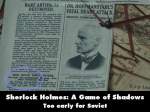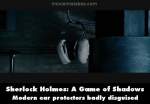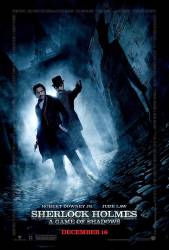
Factual error: When Watson is looking at the spiderweb of clues in Holmes' apartment, he is shown a newspaper article about the bombing and doctor's death. The lower left of the clipping shows a story with title "Soviet Government Money For The General Strike." The movie is set in 1891, and the term Soviet first came into use in 1905 to describe a worker's movement in Russia, but a Soviet Government didn't exist until 1917. (00:16:00)
Factual error: In Paris, Colonel Moran gives a ticket for Don Giovanni to Moriarty. The ticket lists the performance date as "Mardi 7 Novembre." Mardi means Tuesday in French, except in 1891 November 7 was a Saturday. (00:52:20)
Factual error: The map shown in the factory scene uses the post WWI Western boarders of Germany, when it should have included northern Sleswik (today in Denmark) as well as Alsace Lorraine (today in France). (01:18:30)
Factual error: On the train after escaping the munitions factory, Holmes stops breathing and after checking for a pulse, Watson begins chest compressions. This is taking place in 1891, however chest compressions were only first proposed in academia in 1891 and the first successful use wasn't until 1903, and even then wasn't in the CPR fashion Watson was using. (01:34:00)
Factual error: In the scene straight after the opening credits we are taken to Baker Street where construction work is being done. This work is identified by a sign with a logo as being for the underground line. The logo type face was developed by a Mr. Edward Johnston for London Underground from 1913 but the distinctive typeface used in the film was not in place until 1919. This is obviously long after the 1891 setting of the film.
Factual error: In the scene where Holmes enters the factory in Germany, a map can be seen on a table with small German black-red-gold tricolor flags sticking up from it. However, the flag of the 2nd German Empire at the time of the film's setting (1891) was black, white, and red, and was so from 1871-1918.
Factual error: In the opening scene Watson is typing on an Underwood typewriter. Given the last scene of the movie, the first scene took place shortly after Holmes' "death", namely in 1891, or maybe 1892. Underwood started making typewriters in 1895 but those were labeled as "Wagner." The Underwood label was first used in 1900.
Factual error: In the scene at the peace-conference, Sherlock says that he had been to one of the professor's lectures in Oslo, although Oslo was called Christiania during Sherlock's entire life period, and wasn't renamed before 1925.
Factual error: When Holmes and Watson climb back into the train carriage, Watson pulls the door shut with ease. As the train is going quite fast (50+ mph) and the door opens against the carriage it would be take a lot more effort to close, as he is pulling it against the wind the train is producing.
Factual error: At one point, Sherlock uses a tube of lipstick to sabotage a gun. The film is set in the late 19th century, and tube lipstick wasn't available until 1915.
Factual error: At the end of the film as both men go through the motions of what may happen Moriarty uses the term the haymaker punch. The film is set in 1891 and the term haymaker punch wasn't introduced until the early 20th century, about 1917.
Factual error: In the scene where Renè was dying, Dr. Watson examines the dying man and the poisonous arrow that hit him, and concludes that the venom used was curare. Curare is a paralysing poison that causes the body to relax to the degree that respiratory muscles stop contracting and the victim dies of asphyxiation. René on the other hand perished in strong cramps and foaming of his mouth.

Factual error: When Watson is pinned down by Moran at the arms factory in Germany, he hides behind a large artillery piece. He looks around and sees a pair of hearing protection. They appear to be modern hearing protection ear muffs, wrapped with cloth to make them look period. They have plastic clips to detach the ear cups from the metal band, which gives them away as being modern. They appear to be Peltor style hearing protection.






Answer: That sounds entirely right. Bombs are potentially unreliable; it's possible, albeit unlikely, that Meinhard could have survived the blast, so by getting Moran to shoot him dead first, then covering up the true cause of death (and thus who the real target was) using the bomb, it ensures that the job gets done.
Tailkinker ★